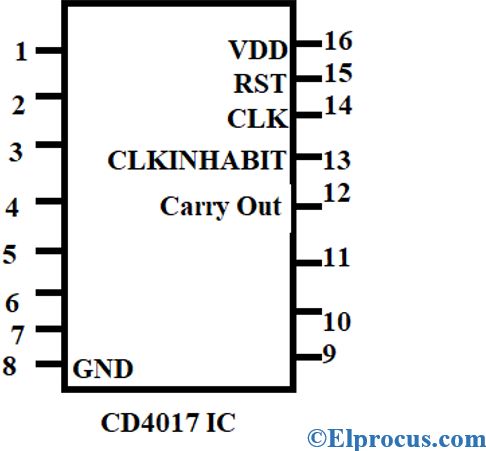Simple Clap Switch
Q ) What is Clap Switch?
Clap Switch:
- Simple clap switch project details
Video Documentation:
Components required:
- IC ( CD 4017 )
- Transistor ( BC 547 )
- Transistor ( BC 557 )
- Resistor 1K
- Resistor 15K
- Mic
- 5V Relay
- 9V Battery
- Coil
CD 4017
It is a CMOS divider or a counter IC. On receiving an external clock signal it turns ON (say all together 10 lights) all the lights in a sequential manner. It consists of input pins 3 in number and output pins 10 in number and a GND – ground pin as shown below
Input Pins
The followings are the input pins used in 4017 decad counter ic
- Reset (P 15): This pin helps to reset the position back to zero. Suppose you want the counter to count to 3, after the 3rd signal the reset pin goes back to zero.
- Clock pin ( P 14): It is an input clock signal pin that goes high when the circuit is in the working stage.
- Clock Inhibit Pin (Pin 13): This pin controls the counter pin by turning it ON and OFF. When Pin13 is set high it means the counter is turned off, and when pin13 is set low it means the counter is turned on.
Output Pins
The followings are the output pins used in 4017 decad counter ic
- Output Pins (0 to 9): These pins process the task sequentially and provide an output at pin3 (let us assume we are using only pin 3 out of 10 output pins).
- Carry Out Pin ( Pin 12): Connect many CD4017 IC together.
Clap Switch Working
Assume a human standing closer to the mic and clapping. This mic takes the sound energy and converts it into an electrical signal and gives this input to the clap switch circuit at transistor T2. This signal in return triggers IC1 ( 555 Timer) pin2. We can theoretically calculate the output clock signal status using the following formula
T = 1.1 * R 5* C 4
The output which is a clock signal from IC1 (pin3) is given as input to CD 4017 IC (pin 14). Now CD 4017 IC starts counting from “0” until pin 14 goes high. On receiving the input signal on the first clap, Q1 gets activated, and LED 1 (d1) starts glowing. The switch circuit is controlled by a relay and the output is obtained from pin2. Similarly, on receiving another clap, pin4 gets activated and LED2(d2) if connected glows and LED1 stops glowing, likewise, this process continues.
Advantages
- Automatically controls lights within a specified range by clapping action
- It is an advantageous technology for mobility-impaired person
- Reliable
- Cost is low
- It provides good output efficiency.
Disadvantages
The following are the disadvantages of clap switch
- It is cumbersome compared to traditional control switch
- The filter should be added in the circuit compulsorily for working.









0 Comments
Have any doubts then contact us please: